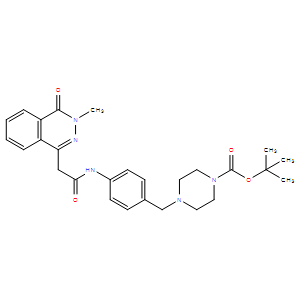| Cas No.: | 1311174-68-1 |
| Chemical Name: | 4-[[4-[[2-(3,4-Dihydro-3-methyl-4-oxo-1-phthalazinyl)acetyl]amino]phenyl]methyl]-1-piperazinecarboxylic acid 1,1-dimethylethyl ester |
| Synonyms: | PH002,PH-002,PH 002 |
| SMILES: | N(C(OC(C)(C)C)=O)1CCN(CC2=CC=C(NC(CC3C4=C(C=CC=C4)C(=O)N(C)N=3)=O)C=C2)CC1 |
| Formula: | C27H33N5O4 |
| M.Wt: | 491.58 |
| Sotrage: | 2 years -20°C Powder, 2 weeks 4°C in DMSO, 6 months -80°C in DMSO |
| Description: | PH-002 is an inhibitor of apolipoprotein (apo) E4 intramolecular domain interaction in neuronal cells that could rescue impairments of mitochondrial motility and neurite outgrowth. |
| In Vivo: | PH-002 is also shown to increase COX1 levels in primary neurons from NSE-apoE4 transgenic mouse cortex and hippocampus. After 4 days of treatment with PH-002 (200 nM), COX1 levels are increased by ~60%. PH-002 (100 nM) increases dendritic spine development in primary neurons from NSE-apoE4 transgenic mice to levels comparable with those in NSE-apoE3 primary neurons (apoE3-expressing primary neurons treated with PH-002 gave results identical to untreated primary neurons)[2]. |
| In Vitro: | PH-002 is an inhibitor of apolipoprotein (apo) E4 intramolecular domain interaction in neuronal cells, with an IC50 of 116 nM in FRET[1]. |

 DC Chemicals' products qualify for U.S. tariff exemptions. We guarantee no price increases due to customs duties and maintain stable supply, continuing to deliver reliable research solutions to our American clients.
DC Chemicals' products qualify for U.S. tariff exemptions. We guarantee no price increases due to customs duties and maintain stable supply, continuing to deliver reliable research solutions to our American clients.





















